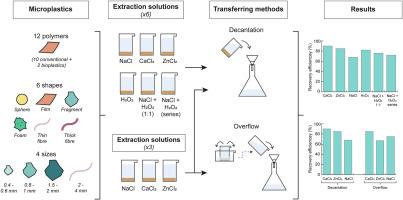密度分离法提取沉积物中微塑料的最佳方法比较
IF 7.3
2区 环境科学与生态学
Q1 ENVIRONMENTAL SCIENCES
引用次数: 0
摘要
海洋是微塑料的重要储存库,它们大多积聚在沉积物中。从沉积物中提取MPs仍然具有挑战性,强调需要一种标准化的方法来进行研究间的比较。比较了常用的密度分离溶液和两种转移方法的效率。用decantation的cacl2饱和溶液是最有效的,无论聚合物、大小或形状如何,都能回收90±1%的MPs,并且比用decantation的ZnCl2更安全、更便宜、更快。高密度聚合物更难回收,特别是使用低密度溶液(如NaCl)或溢流法。虽然在CaCl2和滗析的情况下,大小没有影响,但在使用其他溶液或转移方法时,较大的MPs通常具有更好的提取效果。形状影响PET纤维的回复率,NaCl处理的回复率特别低,ZnCl2和CaCl2处理的回复率略低。加入H2O2或NaCl + H2O2均能提高纤维的提取率。我们的研究表明,由于较低的粘度和较少的颗粒粘附到容器表面,在饱和状态下产生中等密度的盐可能优于密度较大的替代品。我们建议将CaCl2与滗析作为标准方案,以最大限度地提高MP回收率并确保可比性。如果使用H2O2,它应该包含在第一次提取运行中。这种方法也适用于类似的基质,如土壤。本文章由计算机程序翻译,如有差异,请以英文原文为准。

Comparing methods for optimising microplastic extraction in sediment through density separation
Oceans constitute a significant sink of microplastics, mostly accumulating in sediment. Extracting MPs from sediment remains challenging, highlighting the need for a standardised methodology to allow comparison across studies. We compared the efficiency of commonly used solutions for density separation and two transferring methods. A CaCl2-saturated solution with decantation was the most efficient, recovering 90 ± 1 % of MPs regardless of polymer, size or shape, and proved safer, cheaper, and faster than the second-best alternative, ZnCl2 with decantation. High-density polymers were harder to recover, especially with low-density solutions (e.g. NaCl) or the overflow method. Although size had no effect in the case of CaCl2 and decantation, larger MPs generally had better extraction when using other solutions or transferring methods. Shape affected PET fibre recovery, which was particularly low with NaCl and moderately lower with ZnCl2 and CaCl2. Adding H2O2 or NaCl + H2O2 enhanced fibre extraction. Our study indicates that salts yielding intermediate densities at saturation may outperform denser alternatives due to lower viscosity and less particle adhesion to container surfaces. We recommend CaCl2 with decantation as a standard protocol to maximise MP recovery and ensure comparability. If using H2O2, it should be included in the first extraction run. This approach may also apply to similar matrices like soil.
求助全文
通过发布文献求助,成功后即可免费获取论文全文。
去求助
来源期刊

Environmental Pollution
环境科学-环境科学
CiteScore
16.00
自引率
6.70%
发文量
2082
审稿时长
2.9 months
期刊介绍:
Environmental Pollution is an international peer-reviewed journal that publishes high-quality research papers and review articles covering all aspects of environmental pollution and its impacts on ecosystems and human health.
Subject areas include, but are not limited to:
• Sources and occurrences of pollutants that are clearly defined and measured in environmental compartments, food and food-related items, and human bodies;
• Interlinks between contaminant exposure and biological, ecological, and human health effects, including those of climate change;
• Contaminants of emerging concerns (including but not limited to antibiotic resistant microorganisms or genes, microplastics/nanoplastics, electronic wastes, light, and noise) and/or their biological, ecological, or human health effects;
• Laboratory and field studies on the remediation/mitigation of environmental pollution via new techniques and with clear links to biological, ecological, or human health effects;
• Modeling of pollution processes, patterns, or trends that is of clear environmental and/or human health interest;
• New techniques that measure and examine environmental occurrences, transport, behavior, and effects of pollutants within the environment or the laboratory, provided that they can be clearly used to address problems within regional or global environmental compartments.
 求助内容:
求助内容: 应助结果提醒方式:
应助结果提醒方式:


